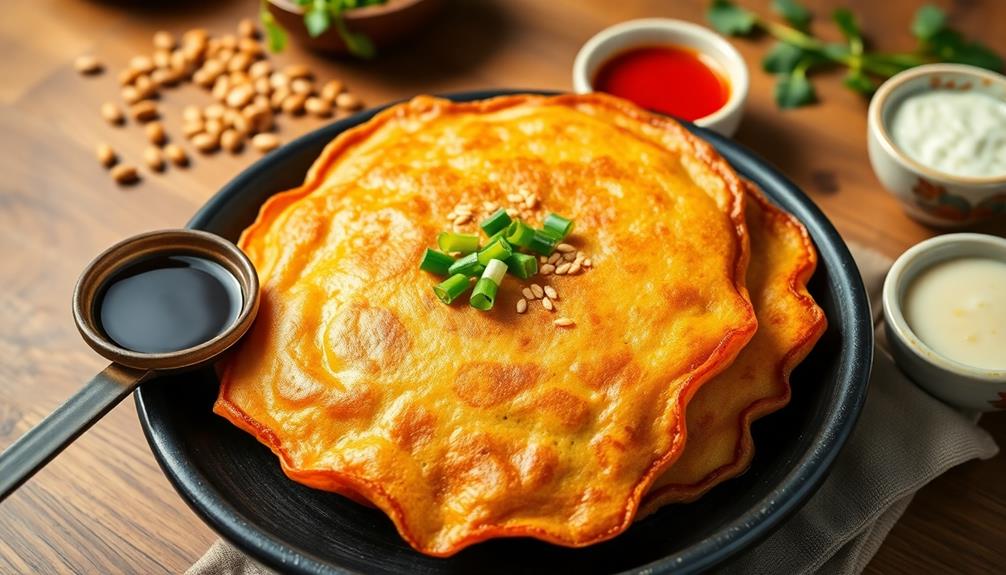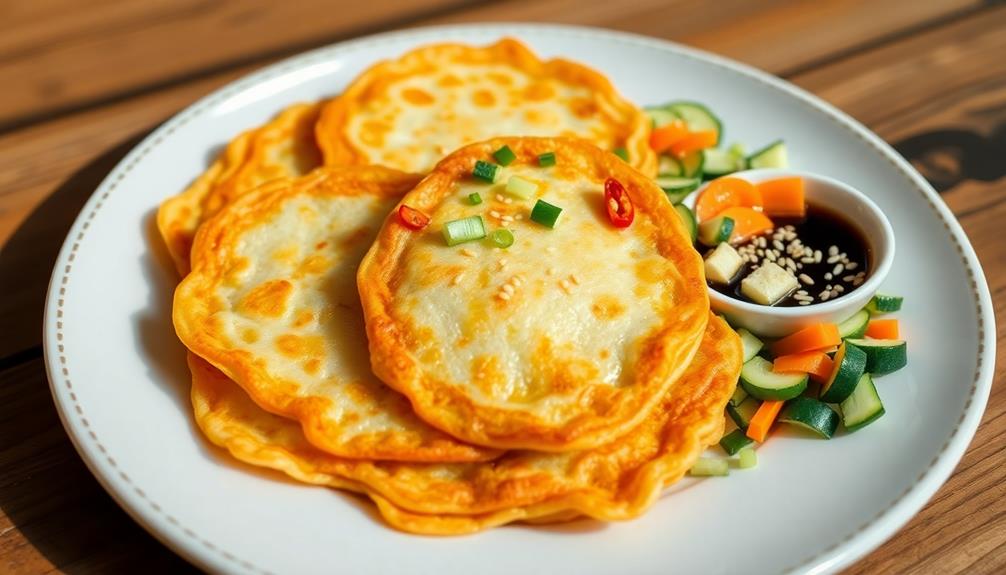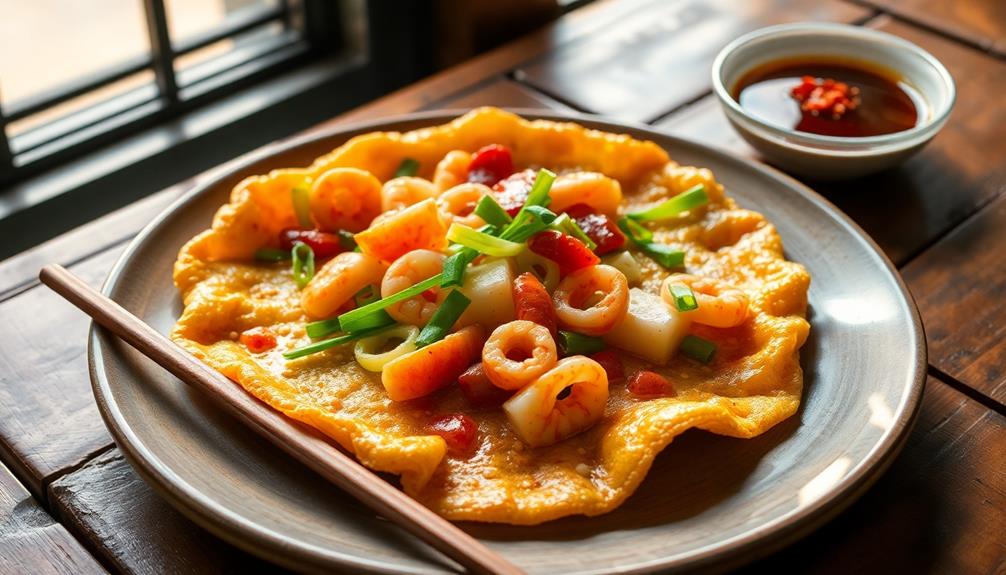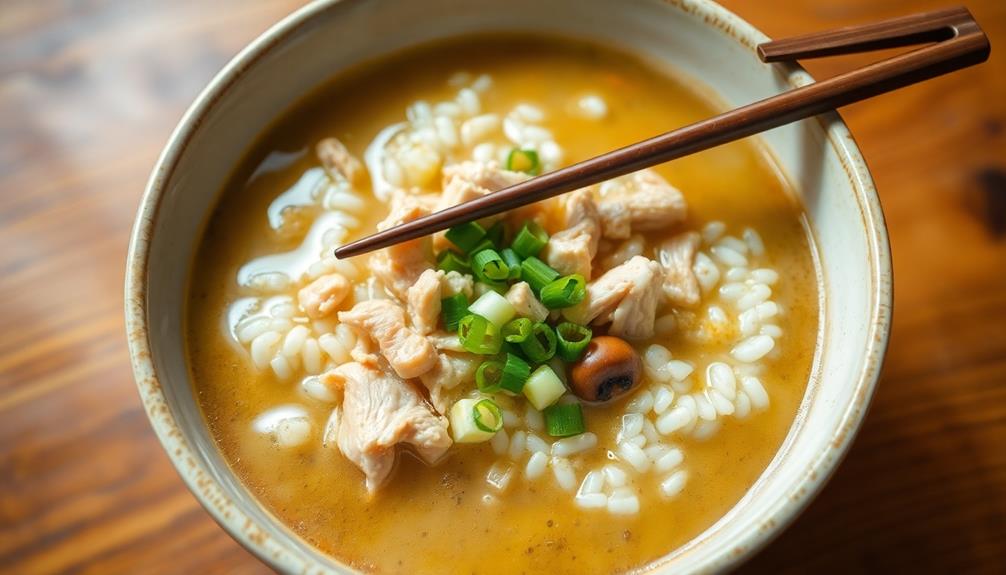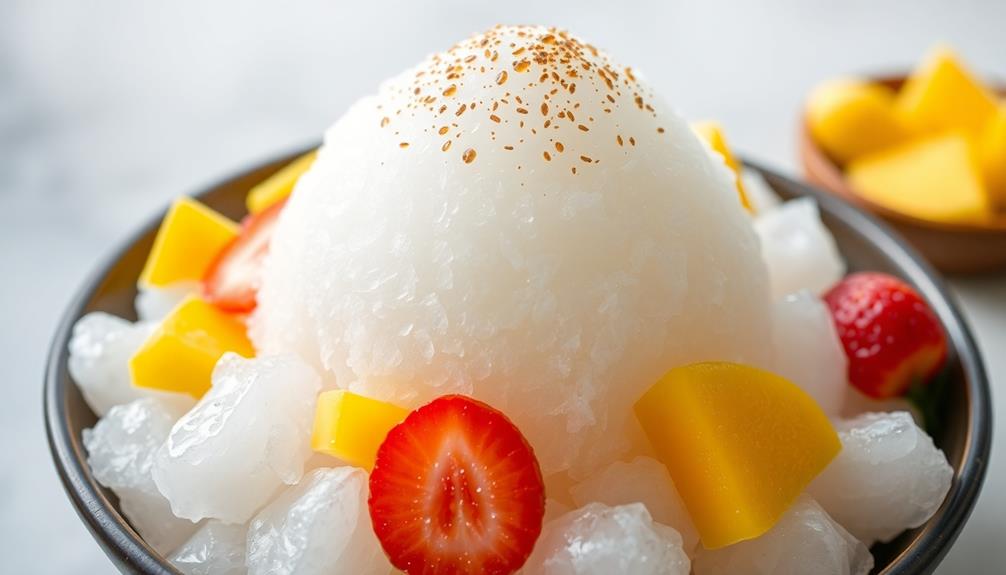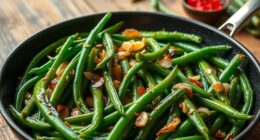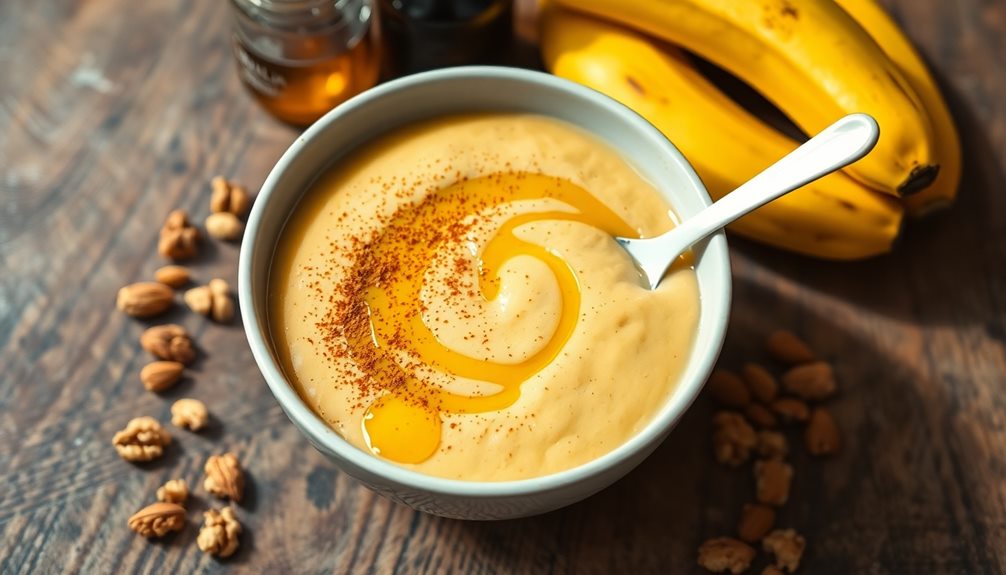Bindaetteok, or mung bean pancakes, are a tasty treat from Korea that you can make at home! They're made by soaking and blending mung beans into a smooth batter, then adding in your favorite veggies and optional meats. Fry them in a pan until they're golden and crispy—yum! Don't forget to dunk them in a simple dipping sauce for an extra flavor boost. This dish is perfect for any meal or even as a snack. Plus, it's great for sharing with family and friends while creating fun memories. Stick around, and you'll discover even more about this delightful dish!
Key Takeaways
- Bindaetteok, or mung bean pancakes, originated during the Joseon Dynasty and were traditionally made for nutritious meals during harvest season.
- The dish features a crispy exterior and tender interior, combining ground mung beans with vegetables and optional meats.
- Common ingredients include soaked mung beans, chopped kimchi, green onions, and ground pork or beef, allowing for customization.
- Bindaetteok is typically served hot with a dipping sauce made from soy sauce, vinegar, and spices for enhanced flavor.
- This dish holds cultural significance, fostering family gatherings and social interaction, often enjoyed at celebrations and festivals.
History
Bindaetteok, a beloved Korean dish, has a rich history that dates back several centuries. It's said that this tasty pancake began its journey during the Joseon Dynasty, around the 15th century. Back then, people used mung beans to create a filling and nutritious meal, especially during the harvest season. Can you imagine farmers enjoying a warm bindaetteok after a long day of work? In modern times, bindaetteok has evolved to include a variety of ingredients such as kimchi, pork, and other vegetables, making it a versatile and flavorful dish. It is often enjoyed as a popular street food in Korea and is also a common dish served in Korean homes. Some people even enjoy pairing bindaetteok with a traditional gyeran jim recipe, a delicious steamed egg dish, for a complete and satisfying meal.
As time went on, bindaetteok became popular in Korean markets and street food stalls. Vendors would fry up these delicious pancakes, filling the air with mouthwatering aromas that made everyone's stomach growl. They'd often add ingredients like vegetables, meat, and spices, making each pancake unique and delightful.
Bindaetteok isn't just a snack; it's a part of celebrations, too! During festivals, families gather to share stories and enjoy this special dish together. It's like a tasty hug in pancake form!
Recipe
Bindaetteok, also known as mung bean pancakes, is a popular Korean dish that combines the nutty flavor of mung beans with a variety of vegetables and meats. This savory pancake is crispy on the outside and tender on the inside, making it a delightful appetizer or snack.
Traditionally, the mung beans are soaked and ground to create a smooth batter, which is then mixed with ingredients such as kimchi, green onions, and even meat or seafood for added flavor.
Preparing Bindaetteok isn't only a culinary adventure but also a way to enjoy the wholesome benefits of mung beans. These legumes are packed with protein and fiber, making the dish nourishing and satisfying. You can customize the filling according to your taste preferences, whether you prefer a vegetarian version or one loaded with meat.
Once you master the basic recipe, you can experiment with different ingredients to make it your own.
Ingredients:
- 1 cup dried mung beans
- 2 cups water (for soaking)
- 1/2 cup kimchi, chopped
- 1/2 cup green onions, chopped
- 1/2 cup carrots, grated
- 1/2 cup ground pork or beef (optional)
- 1/4 cup sesame oil (for frying)
- Salt, to taste
- Pepper, to taste
To prepare Bindaetteok, start by soaking the mung beans in water for at least 4 hours or overnight. Drain and rinse the beans, then blend them in a food processor with a little water until you achieve a smooth batter.
In a mixing bowl, combine the mung bean batter with chopped kimchi, green onions, grated carrots, and ground meat if using. Season the mixture with salt and pepper to taste.
Heat sesame oil in a non-stick skillet over medium heat, then pour in a ladleful of the batter, spreading it into a thin circle. Cook for about 3-4 minutes on each side or until golden brown and crispy.
Repeat the process until all the batter is used, adding more oil as needed.
When cooking Bindaetteok, keep the pancakes thin for the best texture. If they're too thick, they may not cook evenly, resulting in a soggy center.
Additionally, serve the pancakes hot with a dipping sauce made from soy sauce, vinegar, and a sprinkle of sesame seeds for an extra layer of flavor. Enjoy your homemade Bindaetteok as a delightful snack or appetizer!
Cooking Steps
Get ready to make some delicious bindaetteok!
First, you'll soak those mung beans overnight, which is super important for the perfect texture.
Then, you'll blend them up, add colorful veggies to the mix, and fry those pancakes until they're golden brown—just like sunshine on your plate!
Step 1. Soak Mung Beans Overnight
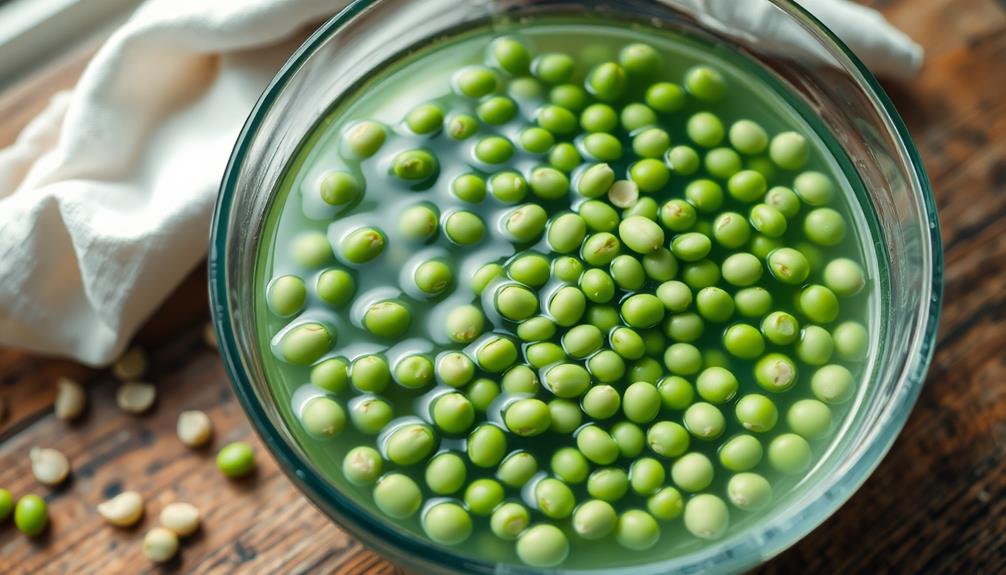
To create the perfect bindaetteok, you'll want to start by soaking mung beans overnight. This step is super important because it helps the beans soften and makes them easier to blend later.
Begin by measuring out about a cup of mung beans. Rinse them under cold water to wash away any dirt or dust. Then, place the rinsed beans in a bowl and cover them with plenty of water. Make sure the water level is a few inches above the beans, as they'll soak up some of that water overnight.
Now, here's a little tip: you might want to set a reminder or leave a note for yourself, so you don't forget about those beans!
After soaking for about 8 hours, the beans will look plump and feel soft when you touch them. That's how you know they're ready for the next step!
If you've got pets, keep an eye on your soaking bowl, as curious critters might think it's a snack!
Step 2. Blend Soaked Mung Beans
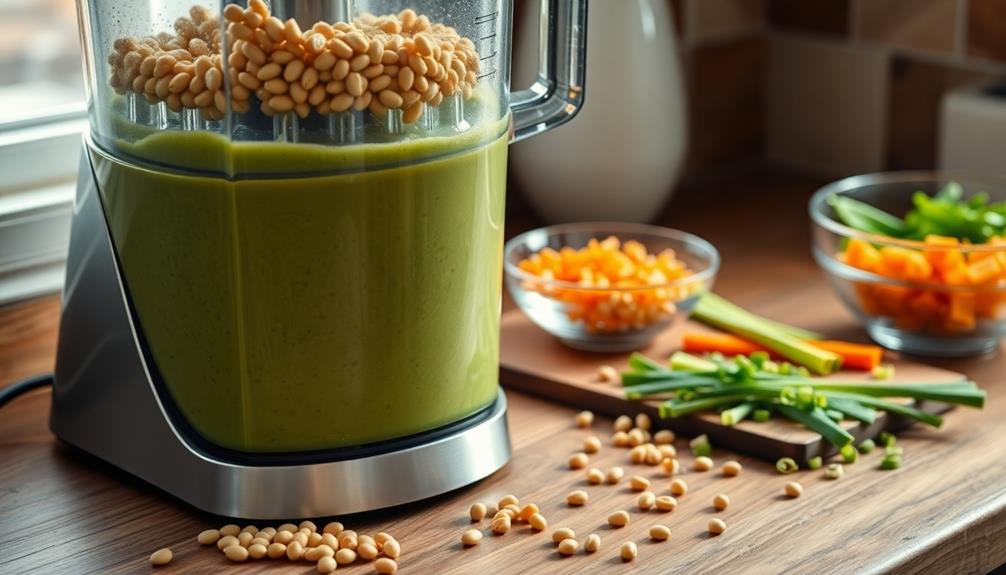
Now that your mung beans are soaked and ready, it's time to blend them into a smooth batter. First, drain the soaked beans and give them a quick rinse to wash away any leftover grit.
Then, toss the mung beans into a blender. Add a cup of fresh water to help things mix smoothly. If you want to keep it simple, stick to just the beans and water. But if you're feeling adventurous, you can add a pinch of salt for flavor!
Secure the lid on your blender, and blend the mixture on high speed until it's creamy and smooth. You might need to stop and scrape down the sides with a spatula to make sure everything mixes evenly.
Don't worry if it seems a bit thick at first; you can always add a little more water to reach your desired consistency.
Once you've got a lovely, smooth batter, you're almost there! Give it a little taste—if you want, you can adjust the seasoning before moving on. Exciting, right? This batter is going to be the base for delicious bindaetteok!
Step 3. Add Vegetables to Mixture

With your smooth batter ready, it's time to enhance it with fresh vegetables. Adding veggies not only makes your Bindaetteok tastier, but it also adds a splash of color and healthiness! You can use a variety of vegetables, so feel free to get creative. Chopped onions, grated carrots, and finely sliced zucchini work wonderfully.
Start by washing and preparing your veggies. Make sure they're clean and cut into small pieces—this helps them mix in nicely.
Now, scoop those chopped vegetables into your batter. Use a spatula or a wooden spoon to fold them in gently. You want to keep that lovely smooth texture while ensuring the veggies are evenly distributed.
Don't forget to add a sprinkle of salt and pepper to season your mixture. If you like a little kick, consider tossing in some chopped green chilies!
Give everything a good mix until all the ingredients are combined, and you'll have a colorful, veggie-packed batter.
Now, take a moment to admire your creation. It looks delicious, and it's time to get ready for the next step—frying those pancakes until they're golden brown!
Step 4. Fry Pancakes Until Golden Brown

It's time to heat up your skillet because frying your Bindaetteok is where the magic happens. First, grab a non-stick skillet and drizzle a good amount of oil into it. You want enough oil to coat the bottom, making sure your pancakes don't stick. Turn the heat to medium-high and let the oil warm up.
Once it's shimmering, it's showtime! Carefully scoop a ladleful of the batter and pour it into the skillet. You can flatten it slightly with the back of the ladle to make it a nice, round shape. Fry the pancake for about 3 to 4 minutes on one side. You're looking for a golden brown color—this is the perfect moment to flip!
Using a spatula, gently turn the pancake over and let it fry for another 3 to 4 minutes. Just imagine the delicious smell filling your kitchen!
If you're making multiple pancakes, you can keep adding more batter, but make sure not to overcrowd the skillet. Once they're all crispy and golden, you'll know you've created something special. Keep that energy up; you're almost there!
Step 5. Serve With Dipping Sauce
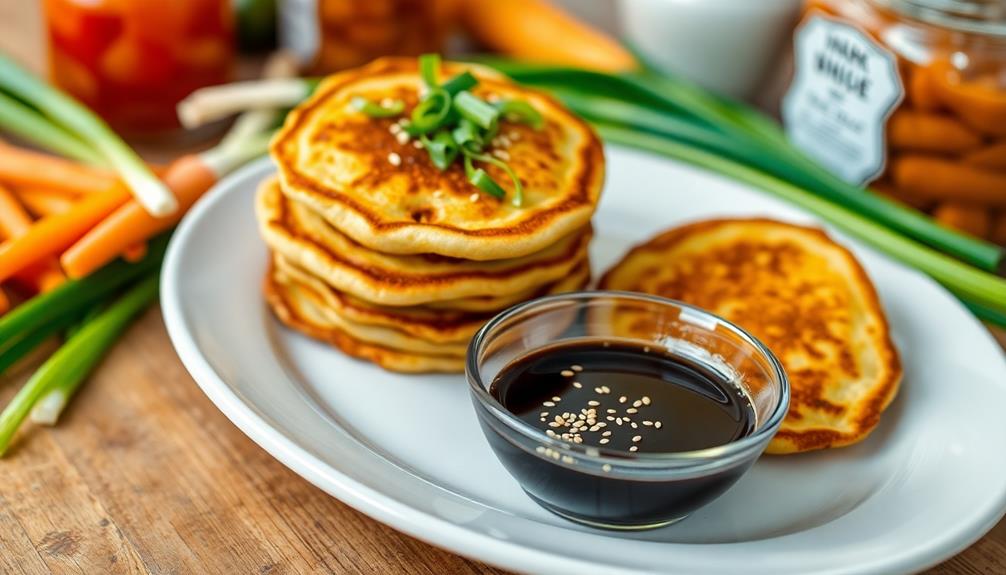
After frying those delicious Bindaetteok to golden perfection, it's time to enhance their flavor with a delightful dipping sauce. You can whip up a simple dipping sauce that'll make your pancakes shine!
Start with some soy sauce, about two tablespoons will do. Next, add one tablespoon of vinegar for that tangy kick. If you like a little heat, sprinkle in a tiny bit of red pepper flakes. You can adjust this based on how spicy you want it—just remember, a little goes a long way!
Now, here's a fun twist: chop up some green onions and toss them in the sauce. They'll add a fresh crunch that pairs perfectly with your crispy pancakes.
Mix everything together in a small bowl and voilà, your dipping sauce is ready!
When you're ready to eat, dip each Bindaetteok into the sauce, and take a big bite. The combination of crispy, savory pancakes with the zesty sauce will make your taste buds dance!
Final Thoughts
Bindaetteok's unique blend of flavors and textures makes it a delightful addition to any meal. Imagine biting into a crispy pancake, filled with the earthy taste of mung beans, and savoring the fresh crunch of vegetables.
It's not just tasty; it's also a fun dish to make! You can whip up a batch for breakfast, lunch, or even dinner, and it's sure to impress your family and friends.
Making bindaetteok is like a little cooking adventure! You'll mix the mung beans, chop the veggies, and fry them until golden brown.
Plus, you can get creative with what you add! Want to toss in some shrimp or other veggies? Go for it! You can even experiment with different dipping sauces to find your favorite.
In the end, bindaetteok isn't just food; it's a way to share culture, stories, and laughter around the table.
So, grab your ingredients, invite some friends, and enjoy the process. Trust me, you'll love the delicious results, and you might even start a new family tradition.
Frequently Asked Questions
Can I Freeze Leftover Bindaetteok for Later Use?
Yes, you can freeze leftover food for later use. Just make sure to cool it completely, wrap it tightly in plastic, and store it in an airtight container. It'll stay fresh for a few months.
What Dipping Sauces Pair Well With Bindaetteok?
You'll love dipping your savory pancakes in a mix of soy sauce and vinegar for a tangy kick. Garlic soy sauce or a spicy gochujang blend also adds depth and enhances the overall flavor experience.
Is Bindaetteok Gluten-Free?
Yes, it is gluten-free! When you make it with mung beans and the right ingredients, you can enjoy a delicious dish without worrying about gluten. Just ensure all components are certified gluten-free for safety.
How Long Can I Store Cooked Bindaetteok?
You can store cooked food in the fridge for about three to four days. If you want to keep it longer, consider freezing it; just make sure to wrap it well to avoid freezer burn.
Are There Vegetarian Options for Bindaetteok Fillings?
Yes, you've got plenty of vegetarian options for fillings! Consider using mushrooms, zucchini, or spinach. You can also mix in tofu or a variety of vegetables to create a delicious, meat-free version. Enjoy experimenting!
